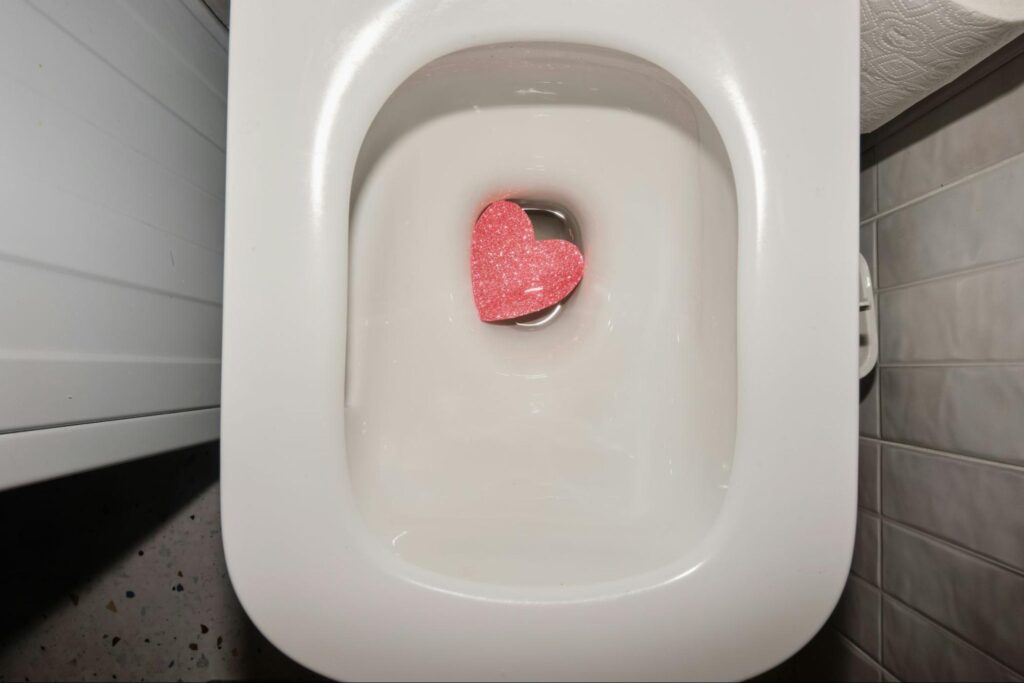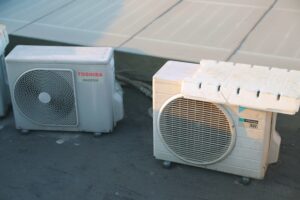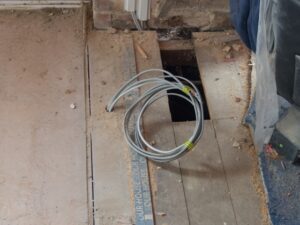An overflowing toilet—talk about a plumbing nightmare, right?
But don’t panic. The first thing you need to do is stop the water from pouring out. How?
Simple—turn off the valve behind the toilet. It’s usually a quick twist and it stops the flow of water, saving you from a flooded floor!
Once that’s done, it’s time to take on the cause of the overflow.
Often, it’s just a clog. A good old plunger can be your best friend here. If that doesn’t cut it, though, you might need to break out the toilet auger, a tool that reaches deep into your pipes to clear even the toughest blockages.
Still stuck? It might be time to call in the pros. That’s where we come in!
Excel Mechanical is your trusted partner for all things plumbing, offering expert solutions tailored to your specific needs. We’re here to make sure your plumbing system runs smoothly, whether you’re at home or managing a business.
In this blog, you will learn:
- The immediate actions you should take to stop an overflowing toilet from causing damage.
- Common causes of toilet overflow and how to identify them.
- How to prevent toilet overflow from happening in the future.
Let’s get started!
Understanding the Cause of Toilet Overflow
An overflowing toilet can be a real hassle. To address it, you first need to understand the root cause, which often involves several factors.
- Clogged Pipes: A common cause is clogged pipes. Items like too much toilet paper or foreign objects can block the pipes, leading to overflow.
- Faulty Flapper: The flapper is the rubber part at the bottom of the tank. If it doesn’t seal properly, water will keep flowing, causing an overflow.
- Blocked Vent Pipe: The vent pipe helps regulate air pressure in the plumbing system. It can cause water to back up and overflow when it gets blocked.
- Fill Valve Malfunction: If the fill valve is broken, the tank can overfill, spilling water over the edge.
Preventing toilet overflow involves identifying these issues early on. Regular maintenance can help you avoid larger plumbing problems.
Immediate Actions to Stop Overflow
Quick action is essential to prevent damage when your toilet starts to overflow. First, stay calm and act promptly.
1. Shut off the Water Supply
- Locate the shut-off valve behind the toilet.
- Turn it clockwise to stop the water flow.
- If it’s stuck, move to the next step immediately.
2. Remove the Tank Lid
Carefully take off the tank lid and set it aside.
3. Stop the Water Inside the Tank
- Push the flapper down to stop water flowing from the tank to the bowl.
- You might need to reach inside; do this with care.
4. Prevent Further Overflow
Use a plunger to push any blockages through gently. Avoid aggressive plunging, which might cause splashbacks.
5. Clean Up Water
Use towels or a mop to soak up water on the floor to prevent slipping or water damage.
6. Call Professionals if Needed
If overflow continues or you can’t resolve the issue, contact a plumber. Excel Mechanical offers expert HVAC and plumbing services, ensuring efficient and effective solutions tailored to your needs.
Immediate action is crucial to managing an overflowing toilet properly.
Tools and Materials Needed for Repair
To fix an overflowing toilet, start by gathering the right tools.
- You’ll need a plunger to clear blockages.
- If that doesn’t work, a toilet auger might be necessary to reach further.
- Other useful tools include a screwdriver and a wrench. These help adjust parts like the fill valve or flapper.
- Keep rubber gloves handy for hygiene and to protect your hands.
- Cleaning cloths or sponges are helpful for wiping spills and tidying the area.
- If the existing parts are worn out, replacement parts like a new flapper, fill valve or overflow tube may be needed. You can find these at most hardware stores.
- When working on the tank, a bucket can catch excess water. If there are leaks, sealing tape might also be needed to secure connections.
Before starting your repair, gather these tools and materials, and you’ll be well-prepared to handle most toilet issues efficiently.
Clearing Simple Clogs
Sometimes, toilets can clog due to excess toilet paper or small objects. If you face this issue, start with a few simple steps to fix it yourself.
Materials Needed:
- Plunger
- Rubber gloves
- Bucket
Step-by-Step Guide:
- Use a Plunger: Place the plunger over the toilet drain and push down gently. Make sure there’s enough water to cover the plunger’s rubber cup. Create a vacuum by pulling up and pushing down until the water drains.
- Hot Water Trick: Pour hot (not boiling) water into the toilet bowl from waist height. This can help break up the clog with gravity and heat.
- Add Dish Soap: Pour a few tablespoons of dish soap into the toilet. Let it sit for 10 minutes. The soap can help lubricate and loosen the clog.
- Baking Soda and Vinegar: Pour one cup of baking soda, then one cup of vinegar into the toilet bowl. The fizzing action can help dislodge the clog. Let it sit for a few hours before flushing.
- Check Your Success: Try flushing again to see if the clog has cleared.
Using everyday items can save you a service call.
Dealing with Complex Blockages
When dealing with complex blockages in your toilet, you might need to try several methods. Simple clogs often clear with a plunger, but tougher blockages can be tricky.
- Start by using a plumber’s auger. This tool, also called a snake, helps reach deeper clogs that a plunger can’t. Be gentle to avoid damaging the pipes.
- If that doesn’t work, hot water and dish soap might help. Pouring hot water into the bowl can soften the blockage, especially if it’s caused by greasy materials. Be careful not to overflow the toilet while doing this.
- For more stubborn issues, mixing baking soda and vinegar can create a fizzy reaction that helps break down clogs. Pour the soda in first, followed by vinegar, and let it sit. This can also help with odors.
- Remember, if tackling complex blockages becomes too challenging, it’s wise to call in professionals. At Excel Mechanical, we offer reliable plumbing services with a focus on quality and value. Our team is ready to assist with both residential and commercial needs.
Adjusting the Float Mechanism
If your toilet is overflowing, the float mechanism might need adjusting. This device controls the water level in the tank.
Steps to Adjust
- Locate the Float: Open the tank lid. Look for a float ball or cup—it rests on the water.
- Check the Water Level: Identify the ideal water level mark, usually about 1 inch below the overflow tube.
- Adjust the Float: For float balls, gently bend the arm. Move the clip along the rod to adjust the water level for cup floats.
Tips
- Consider a replacement if the float is damaged or won’t hold position.
- Make small adjustments and test each time to avoid overcorrection.
Repairing or Replacing Toilet Components
If your toilet is overflowing, it might be due to faulty components.
- Float issues can cause water to keep running. If the float is set too high, it won’t stop water flow. Adjust the float or replace it to fix this problem.
- Another common issue is a worn flapper. When the flapper doesn’t seal properly, water leaks into the bowl, leading to continuous running and possible overflow. To fix this, inspect the flapper for damage. If it’s worn, it’s a simple replacement.
- A damaged fill valve might also be at fault. If it’s not functioning correctly, the tank might not fill properly. Replacing the fill valve can solve this issue. It’s a relatively easy DIY task with the right tools.
- In some cases, the whole toilet assembly may need upgrading. This is especially true if multiple components are failing. When deciding, consider your needs and budget.
Preventive Maintenance
Regular maintenance can help prevent toilet overflows.
- Start by checking the components inside the tank, like the flapper and fill valve. These parts should be in good condition and working properly.
- Replace old or worn-out parts. This simple step can avoid many plumbing issues.
- Be mindful of what you flush. Only flush toilet paper and waste. Items like wipes, sanitary products, or too much paper can cause clogs. This small habit can save you big repairs down the line.
- Clean your toilet frequently. A clean toilet is less likely to clog. Use a toilet cleaner to keep everything fresh and functioning well. Scrub the bowl regularly to remove buildup.
- Consider installing a water-saving toilet. These toilets use less water per flush, reducing the risk of overflows and cutting down on water bills.
- Keep a plunger handy. It’s a quick tool to clear minor clogs. Ensure it’s in good condition and ready when you need it.
When to Call a Professional
Sometimes a toilet problem is too complex to handle alone. Knowing when to call a professional can save you time and stress.
- Persistent Clogs: If the toilet remains clogged after you’ve tried a plunger or a toilet brush, it might be time to seek help. This can indicate a deeper plumbing issue.
- Water Damage: An overflowing toilet can lead to water damage. A professional inspection is wise if you notice water seeping into the floor or walls.
- Foul Odors: Bad smells that don’t disappear could signal a sewer line problem. Having an expert check is best because it can lead to health concerns.
- Repeated Issues: If clogs or overflows happen frequently, an underlying issue might need professional attention. Calling a professional can prevent more serious problems.
Excel Mechanical offers top-quality plumbing services for both homes and businesses. Our experts are skilled in identifying and resolving complex issues, ensuring the best system for your needs and budget.
Frequently Asked Questions
Let’s face it—an overflowing toilet is one of those problems no one wants to deal with. But don’t worry, we’ve got you covered with answers to some common questions that pop up when your toilet overflows.
What steps should you take when your toilet overflows after flushing?
First, turn off the water supply. This stops more water from filling the bowl. Next, grab a plunger and try to clear the blockage. Make sure you create a good seal with the plunger for effective plunging.
How can you repair an overflowing toilet if you do not have a plunger?
Use dish soap and hot water. Pour a generous amount of dish soap into the toilet, followed by hot (not boiling) water. Let it sit for a while to help break down the clog. If this doesn’t work, a toilet brush can create pressure to help clear the blockage.
What causes a toilet to start overflowing from the tank?
Faulty parts in the toilet tank can cause overflows. A malfunctioning fill valve or a broken flush valve are common culprits. You may need to adjust the tank’s components or replace parts to prevent future overflows.
What are the methods to prevent a toilet from overflowing when it’s clogged?
Quickly remove excess water from the bowl with a cup or small bucket. This reduces the chances of overflow. Also, inserting the plunger early can help manage minor clogs before they become a bigger problem.
What should you do immediately when your toilet overflows with solid waste?
Wear gloves and use a bucket to scoop out any excess water and waste. This prevents spillage onto the floor. Disinfect the area thoroughly afterward to maintain hygiene.
How to fix a toilet if it fills up with water and drains slowly after flushing
Check for partial clogs in the drain. Use a plunger to clear these clogs. If a plunger doesn’t work, consider using a toilet auger for deeper blockages.




